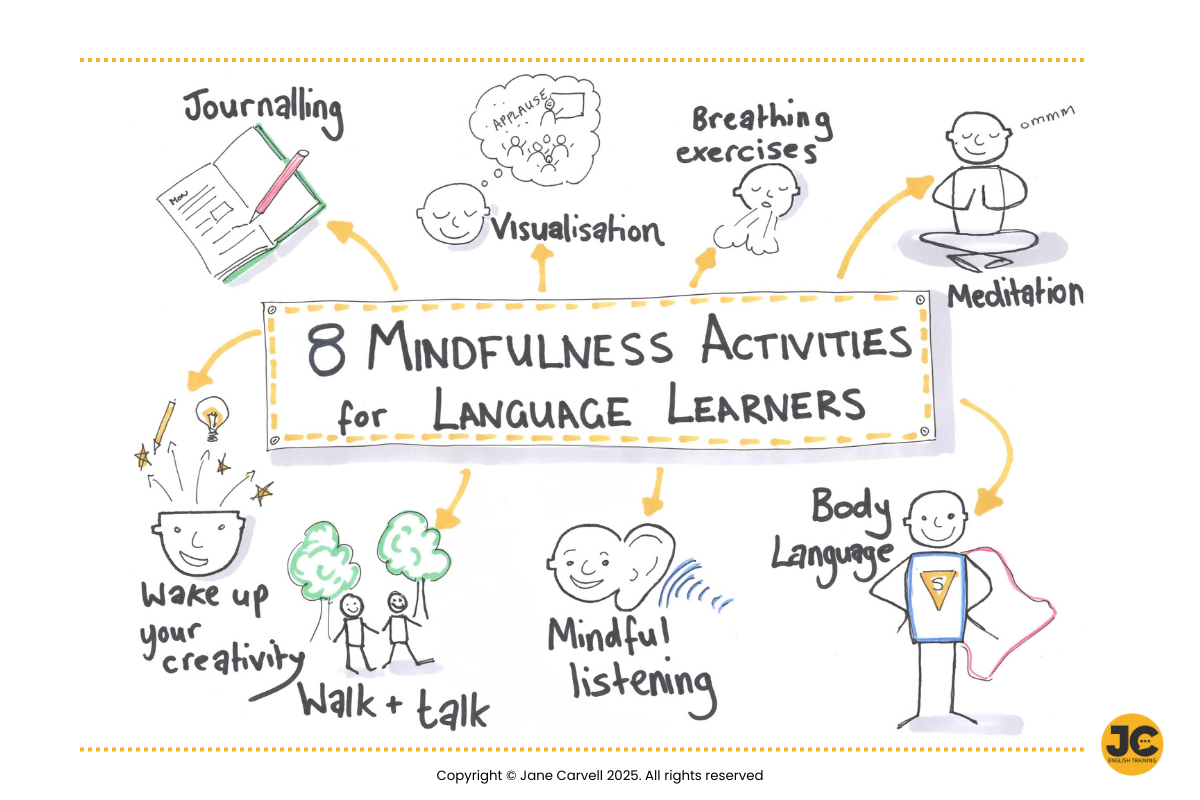8 Mindfulness Activities to Boost Language Learning
Integrating one or two mindfulness practices into your language learning can make a big difference to your focus, memory and self-confidence. We often deal with a stream of deadlines, meetings and everyday stress meaning it can be hard to find the concentration needed to develop a new skill, such as improving your English.
How can mindfulness help with language learning?
I’ll explore 8 practical mindfulness activities you can use to improve focus, reduce stress, and learn more effectively. The tips will show you how to transform language learning into a calm, positive, and productive experience.
1. Language Learning Journals
Writing in a journal is a great way to improve language skills. You could write short reflections in English about your day, your goals, or even your favourite moments from the week. This not only builds writing skills but also helps maintain a positive mindset by focusing on progress rather than perfection.
Notebooks like the Fluentish language journal by Jo Franco provide structured prompts designed for learners, or you could use an AI tool like ChatGPT to suggest journaling topics for your personal interests.
2. Visualisation Exercises and Positive Affirmations
Visualisation helps reduce anxiety and build confidence. Before a big presentation, take a moment, close your eyes and imagine yourself speaking smoothly in English. Picture the expressions of understanding and engagement on your colleagues' faces. (I know this might sound a bit ‘woo woo’, but why not give it a try? 😊)
Pair this with positive affirmations such as, “I am becoming a confident English speaker,” or “I communicate effectively in my meetings.” These practices help shift your mindset and reduce the fear of making mistakes.
3. Focused Breathing Exercises
If you are anxious about speaking English, breathing exercises can calm the mind and prepare you. One simple technique is circular breathing: inhale deeply for four counts, hold for four counts, exhale for four counts, and pause for four counts. Repeat this cycle a few times before practicing English or heading into a meeting.
This reduces stress and improves focus, helping you stay attentive during conversations or learning sessions.
4. Mindfulness Meditation
If it works for elite sportspeople or top entrepreneurs, it can work for you! Short (even just 5 minutes) meditation sessions can create mental clarity and reduce stress, so you can focus on language learning. You can find out more about the science behind the benefits of mindfulness meditation in this video from Global News: https://youtu.be/g7yFvd7_KVw.
5. Wake Up Your Creative Side
A creative warm-up boosts both focus and attention. One of my favourite activities to begin a session is ‘creative circles’: get a piece of paper with circles and turn as many as you can into something else in five minutes. (See examples below).
Although it might not seem directly related to language, this activity sharpens focus and builds the mental flexibility needed for effective learning. You can follow up the sketching part by describing your drawings or even making a short story using the images as prompts.
I first saw this activity in Tim Brown’s TED talk: Tales of Creativity and Play
Examples of the creative circles warm-up.
6. Walk and Talk
Fresh air can do wonders for productivity and mood. Have you thought about taking your English practice outside? You could listen to an English podcast during a walk, practice small talk with a colleague during your visit to the canteen or rehearse a talk while strolling in the sun. The movement and change of scenery make learning more dynamic and enjoyable.
7. Mindful Listening
Active listening is key to language learning. Focus fully on a conversation or audio without planning your next response. Try shadowing: repeat what the speaker says in real time, mimicking their tone and rhythm—a great technique for podcasts. You can also paraphrase: restate the speaker’s message in your own words or as a question to confirm understanding, which assures them they’ve been heard. (I’ll be writing more about activating listening skills in a future blog post).
8. Mindful Body Language
Non-verbal communication is a key aspect of language learning. Practicing mindful body language, such as maintaining eye contact, using open gestures, or even standing in a “Superman pose” for two minutes, can boost confidence and improve how others perceive your communication. (Shhhh, don’t tell anyone but if I’m nervous before I have an important meeting or start with a new group, I really do get ready with my superwoman confidence pose!)
Integrating Mindfulness into Daily Routines
Mindfulness doesn’t need a complete reorganisation of your workday. Start small: pick one or two activities from this list and experiment with them. For example, begin your day with a language learning journal entry or take five minutes before meetings to practice focused breathing. Over time, these habits will become second nature, making language learning both effective and enjoyable.
Ready to Take the Next Step?
I would like to invite you to a discovery call with me. We could talk about a mindfulness-based language coaching session and how to explore these techniques in a personalised and professional context.
Book a free 15-minute discovery call ⬇️
Hello,
I’m Jane Carvell, a business English trainer, language coach and visual thinking enthusiast. I help German-speaking professionals improve their English communication skills, so that they can build better connections to grow in an international working world.



